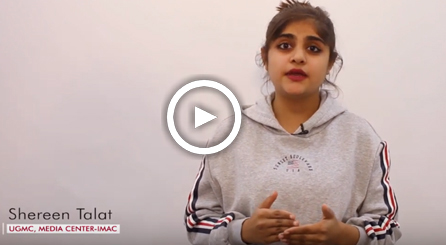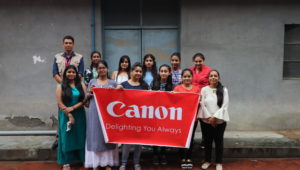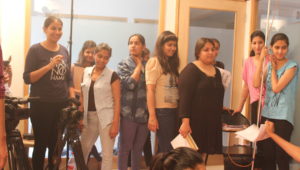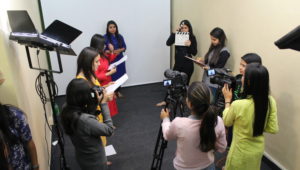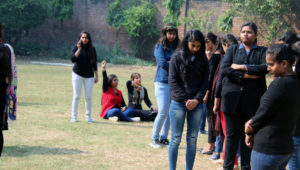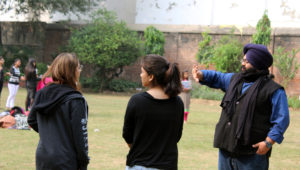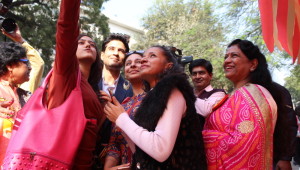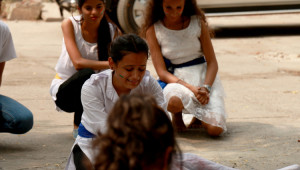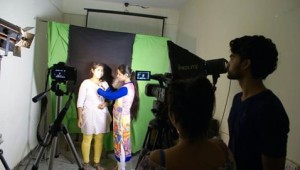Here are 15 basic steps required for an elaborate television production. Once you know the entire process, you can produce videos for any sized production.
- WHAT IS THE PURPOSE OF THE VIDEO PRODUCTION
First of all, clearly define the production’s goals and purposes.
If there are no clear goals and purposes of the production, it will be impossible to evaluate its success.
Identify the purpose. Is it to instruct, inform, or entertain? – Or may be to generate feelings of pride or express a social, religious, or political need? Is the real purpose to create a desire in the audience to take some action?
The primary goal of most broadcasting is simply to attract the interest of an audience in order to influence them with the intervening commercials. Even PBS (public broadcasting service), which used to be commercial free, now runs “mini-commercials” for their corporate underwriters.
- EVALUATE YOUR TARGET AUDIENCE
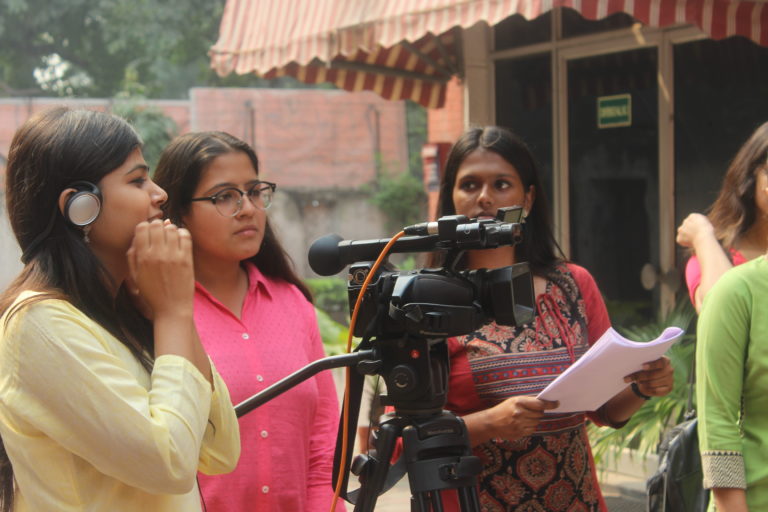
Review and evaluate your target audience on the basis of age, sex, socioeconomic status and educational level, program content preferences. An audience characteristic is termed as demographics.
Check the demographics to determine the acceptability of content you are creating. Knowing your audience is crucial to success and not understanding could result into failures.
Education qualification of your audience is also related. Research shows that, generally the more educated the audience, the less they object to sexual content.
It’s captivating to know that this relationship seems to be the reverse when it comes to violence: more educated audiences are less tolerant of violence in the media.
- LOOK FOR SIMILAR VIDEO PRODUCTIONS
If you’re going to make mistakes, at least make fresh ones.
Ask yourself few questions: How will your proposed production differ from previous successful and unsuccessful efforts by other people? Why did they work; or maybe more significantly, why didn’t they?
Since production styles changes quickly, you need to take into consideration differences in time, locations and audiences.
- ESTABLISH THE BASIC VALUE OF VIDEO PRODUCTION
Determine the overall value of the production to a sponsor or underwriter. It’s obvious that underwriters and advertisers would like some sort of return on their investments.
Firstly, ask yourself some questions. What is the probable size of the audience? In determining this, you must know if your show will be a one shot presentation or if you can get back production expenses over time by presenting the show to different audiences.
At the same time, simple numbers don’t tell the complete story.
Let’s say an advertiser has a product designed for young people – athletic shoes or designer jeans. In this case, a production that draws a large percentage of this age group will be more valuable than a production that has a larger overall audience, but a lower percentage of young people.
Broadcasters have cancelled more than one TV series not because it had a small audience, but because it has the wrong kind of audience.
You’ll always want to balance the potential value of a production to an advertiser or underwriter with the projected cost of producing and presenting the production.
- BUILD A STORY TREATMENT OR PRODUCTION APPLICATION
Write it down on paper. These steps involved span the interval from the initial proposal to the final shooting script. You’ll recall that the earlier we talked about treatments and program proposals (written summaries of what you propose to do).
After the program proposal or treatment is approved, you’ll submit on request a full script.
If it’s an institutional production, you’ll review the production’s goals and pose questions about the most effective ways to present ideas. If the director is on board at this time, he or she should be part of these conferences.
Finally, a script version emerges that is more or less acceptable to everyone. Even this version, however, will probably not be final. In many instances, scene revisions continue right up the time the scenes are shot.
Typically, in a dramatic film production, each new script version is issued on a different color paper so that the cast and crew won’t confuse them with earlier versions. Depending on the production, you may want to develop a storyboard.
A storyboard consists of drawings of key scenes with corresponding notes on elements such as dialogue, sound effects, and music.
- DEVELOP A PRODUCTION SCHEDULE
Next, draw up a tentative schedule. Generally, broadcast or distribution deadlines will dictate the production schedule. Not planning thing out carefully might cause you to miss a critical deadline, rendering the production useless.
- PICK KEY PRODUCTION WORKFORCE
Bring on board the remaining above-the-line production personnel. In addition to the producer and writer, above-the-line personnel include the production manager, director and in general, key creative team members. Below-the-line personnel, generally assigned later, include the technical staff.
- DECIDE THE LOCATIONS
If you’re not shooting in the studio, decide on key locations. In a major production, hire a location scout or location manager to find and coordinate the use of the locations suggested by the script.
Although it might be easier to shoot in a TV studio, it’s been show that audiences like the authenticity of “real” locations, especially in dramatic productions.
Most major cities support TV and film production and maintain film commission that supply photo and videotapes of interesting shooting locations in their area. They’ll also provide information on usage fees and the names of people to contact.
- CHOOSE ON TALENT, COSTUME AND SETS
Next, you’ll want to make some decisions on talent, costuming and sets. Depending on the type of production, auditions may take place at this point as part of the casting process. Once completed, you’ll sign contracts.
If you’re lucky enough to afford well-known actors, you’ll probably have decided on them early in the preproduction process.
Once you decided on the talent, you can begin wardrobe selection. These are suggested by the script, coordinated with the look of the sets and locations, and ultimately approved by the director.
After a set designer is hired, he or she will review the script, possibly do some research, and then discuss initial ideas with the director.
Even though personnel may not have finished the sets at this point, the actor can start reading through the script with the director to establish pace, emphasis and basic blocking (The positioning of sets, furniture, cameras and actors).
- CHOOSE REMAINING PRODUCTION PERSONNEL
Make decisions on the remaining staff and production needs. At this point you can arrange for key technical personnel, equipment and facilities. This includes the rental of both equipment and production facilities.
Next arrange transportation, catering (food and refreshment trucks) and on-location accommodations (for overnight stays).
- OBTAIN PERMITS, INSURANCE AND CLEARANCE
In major cities and in many foreign countries, it is not possible just to go to the location of your choice, setup your tripod and start shooting. Except for spot news short documentary segments, you must arrange access permits, licenses, security bonds, and insurance policies.
Many semipublic interior locations such as shopping malls , require filming permits. (yes , things do get complicated!).
Depending on the nature of the production, liability insurance and security bonds may be necessary, because accidents happen and can be directly and indirectly attributed to the production.
In some locations, the controlling agency will limit exterior production to certain areas and specific hours. In the street scene where traffic will be affected, you’ll need to arrange for special police.
We include in this category a wide variety of clearances, ranging from permission to using prerecorded music to reserving satellite time to transmit the production back to a studio. If you can’t obtain clearance, begin exploring alternatives immediately.
Are you beginning to see why lists or credits in films and TV programs are so long?
- ARRANGE TO SHOOT OR AQUIRE VIDEOTAPE AND FILM INSERTS, STILL PHOTOS, AND GRAPHICS
To trim down production costs, check out existing stock footage in film and tape libraries around the country. This is generally background footage, such as general exterior scenes of an area, to be edited into the production.
If suitable footage is not available or does not meet the needs of the production, you may need to hire a second unit to produce needed segments.
Second unit work is production done away from the main location by the separate production crew. It generally does not involve the principle on-camera talent.
You will be beginning to make decisions on music at this point, including working out copyright clearance and royalties for music and visual inserts.
- COMMENCE REHEARSALS AND SHOOTING
Starts rehearsing and shooting. Depending on the type of production, rehearsals may take place either minutes or days before the actual shooting.
Production shot live on tape (without stopping, except for major problems) will need to be completely rehearsed before recording starts. This includes early walkthrough the rehearsals, camera rehearsals and one more dress rehearsals.
Productions that are shot with single-camera, film style are rehearsed and recorded one scene at a time.
- START ON EDITING PHASE
After shooting is completed, the producer, director and video recording editor review the footage and make editing decisions. This is often done in two phases: on-line and off-line.
Briefly, in off-line editing copies of original taped footage that contains time-code references are used to develop a kind of blue-print for final editing. In on-line editing the original footage is used in editing.
During the final editing phases, sound enhancing, color balancing and special effects are added.
- CARRY OUT POST-PRODUCTION FOLLOW-UPS
Although most of the production crew will conclude their work by the time production finishes, the following follow-up work need to be completed.
Included in this final step is totaling up financial statements, paying the final bills, and determining the production’s success. Ratings indicate success levels in the broadcasts television. In institutional television, it may be testing, program evaluations and viewer feedback.
[This article is published by Media Center-IMAC in interest of student awareness and career guidance. Media Center-IMAC specializes in Post-Graduate/Under-Graduate diploma courses in Media Studies and Mass Communication & TV journalism. With practical oriented and industry specific course, Media Center- IMAC is a prominent institution in Delhi.
Our alumni have proven themselves in the media world and are currently working at prestigious media organizations and top news channels. Besides full time diploma courses, Media Center-IMAC also offers specialized certificate courses in TV reporting, Digital marketing, video editing, radio jockeying, photography and many more.
For more info, visit: http://www.mediacenterimac.com/
Or email at: mediacenterimac@gmail.com
Or call at: 011 43489010, 8076807939.]








